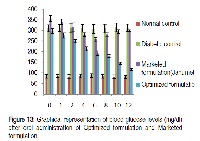Formulation and evaluation of sitagliptin phosphate and metformin hydrochloride trilayered tablets
Keywords:
Hyperglycemia, Metformin HCl, Sitagliptin Phosphate, Trilayered tabletAbstract
Sitagliptin phosphate when used alone is an oral anti hyperglycemic drug of the dipeptidyl peptidase-4 (DPP-4) inhibitor class. It is available as tablets under trade name JANUVIA. Metformin hydrochloride is used alone in the form of biguanide anti hyperglycemic agent for treating noninsulin-dependent diabetes mellitus (NIDDM) and is available as both conventional and sustained release tablets. The objective of the present study was to develop a trilayered tablet of immediate release Sitagliptin phosphate layer and sustained release Metformin Hydrochloride layer. Apart from the aesthetic appeal this trilayered tablet is expected to improve glucose tolerance in patients with the type 2 diabetes by lowering both basal and postprandial plasma glucose, reducing the dose, reducing frequency of administration and dose related gastrointestinal side effects of metformin and improve its bioavailability thus improving the patient compliance. Metformin Hydrochloride has biological half-life of nearly 6 hours. An attempt was made to sustain its release by using two different polymers in two layers. Preformulation studies including drug excipient compatibility studies were conducted for both drugs. Different formulations of sustained release Metformin HCl tablets were prepared by using a combination of hydrophilic polymers like HPMC K100, HPMC K4M, HPMC K15 M, pH sensitive polymer Carbopol 971P, retarding polymer Ethyl cellulose and Low substituted hydroxy propyl cellulose. Sitagliptin immediate release formulations were prepared using cross povidone, croscarmellose sodium and sodium starch glycolate as super disintegrants. The tablets were evaluated for all physico chemical parameters like angle of repose, bulk density, tapped density, Hausners ratio and carrÊs index. Based on the invitro dissolution data the formulations SF6, MF9 and MF8 were found to be the optimized formulations for Sitagliptin phosphate and Metformin Hydrochloride formulations respectively. Trilayered tablets were prepared by first preparing Metformin HCl layers namely MF3 and MF8 using lesser compression force. The final compression was made by placing Sitagliptin IR layer (SF6) on the Metformin layers with final hardness of 6.5 kg and evaluated. The IR layer of Sitagliptin phosphate layer disintegrated in 54.67 sec from the trilayered tablet. In vitro dissolution studies of Trilayered tablet were performed in USP type II apparatus. The cumulative % drug release of Sitagliptin phosphate SF6 was found to be 99.65% at 30 min and Metformin HCl MF3 and MF8 was found to be 98.72 % at 12 hrs. From the study it is found that the formulations made from MF3 and MF8 combination of HPMC K15M and HPMC K4M polymers and SF6 Sodium starch glycolate used as super disintegrant was found to show optimum properties of required drug release.
References
Baptist Gallwitz. Review of Sitagliptin phosphate: a novel treatment for type 2 diabetes Vascular Health and Risk Management 2007:3(2) 203–210.
Rachmani R, Slavachevski I, Levi Z, Zadok B, Kedar Y, Ravid M. Metformin in patients with type 2 diabetes mellitus: reconsideration of traditional contraindications. Eur. J. Intern. Med.2002; 13:428-33.
Debora Williams-Herman, Samuel S Engel, Elizabeth Round, Jeremy Johnson. Safety and tolerability of sitagliptin in clinical studies: a pooled analysis of data from 10,246 patients with type 2 diabetes. BMC Endocrine Disorders. 2010, 10:7.
Kamath et al, Three layer tablet containing Cetrizine, Pseuodephidrine and Naproxen. United States Patent Application Publication,. Pub no: US 2010/0172987 A1. Pub no: Jul.8, 2010.
Basawaraj S, Patil1 NG. Raghavendra Rao. Formulation and Evaluation of Fast Dissolving Granisetron Hydrochloride Tablets: Effect of Functionality of Superdisintegrants. International Journal of Advances in Pharmaceutical Sciences, 2, 2011, 33-39
Durga Prasad Pattanayak, Subash C. Dinda. Bilayer tablet formulation of metformin hydrochloride and glimepiride: A novel approach to improve therapeutic efficacy. International Journal Of Drug Discovery And Herbal Research,1(1),2011, 1-4
Podczeck F, Drake KR, Neton JM, Harian I. The strength of bi-layered tablet. European Journal of Pharmaceutical Sciences. 2008; 1-14
Shajahan Abdul, S.S. Poddar. A flexible technology for modified release of drugs: multi layered tablets. Journal of Controlled Release 97 (2004) 393–405.
Lachman L, Herbert A.Lieberman, Theory and Practice of industrial pharmacy, special Indian edition; 2009, 296-302.
Sundermoorty K., Kavimani S., Vetrchelvan T., Manna P K. and Venkappaya D., Formulation and Evaluation of Extended Release Dosage Form of Metformin Hcl using Combined Hydrophobic and Hydrophillic Matrix, Indian. J, Pharm. Educ. Res 42(3), 2008, 232-242
Amruta B. Loni, Minal R. Ghante, S. D. Sawant. Simultaneous UV Spectrophotometric Method for Estimation of Sitagliptin phosphate and Metformin hydrochloride in Bulk and Tablet Dosage Form. Scholars Research Library Der Pharma Chemica, 2012, 4 (3): 854-859.
Adolfo Andrade Cetto a, Helmut Wiedenfeld b, Ma Cristina Revilla c, Islas A. Sergio, Hypoglycemic effect of Equisetum myriochaetum aerial parts on streptozotocin diabetic rats,Journal of Ethnopharmacology (2000),129-133





